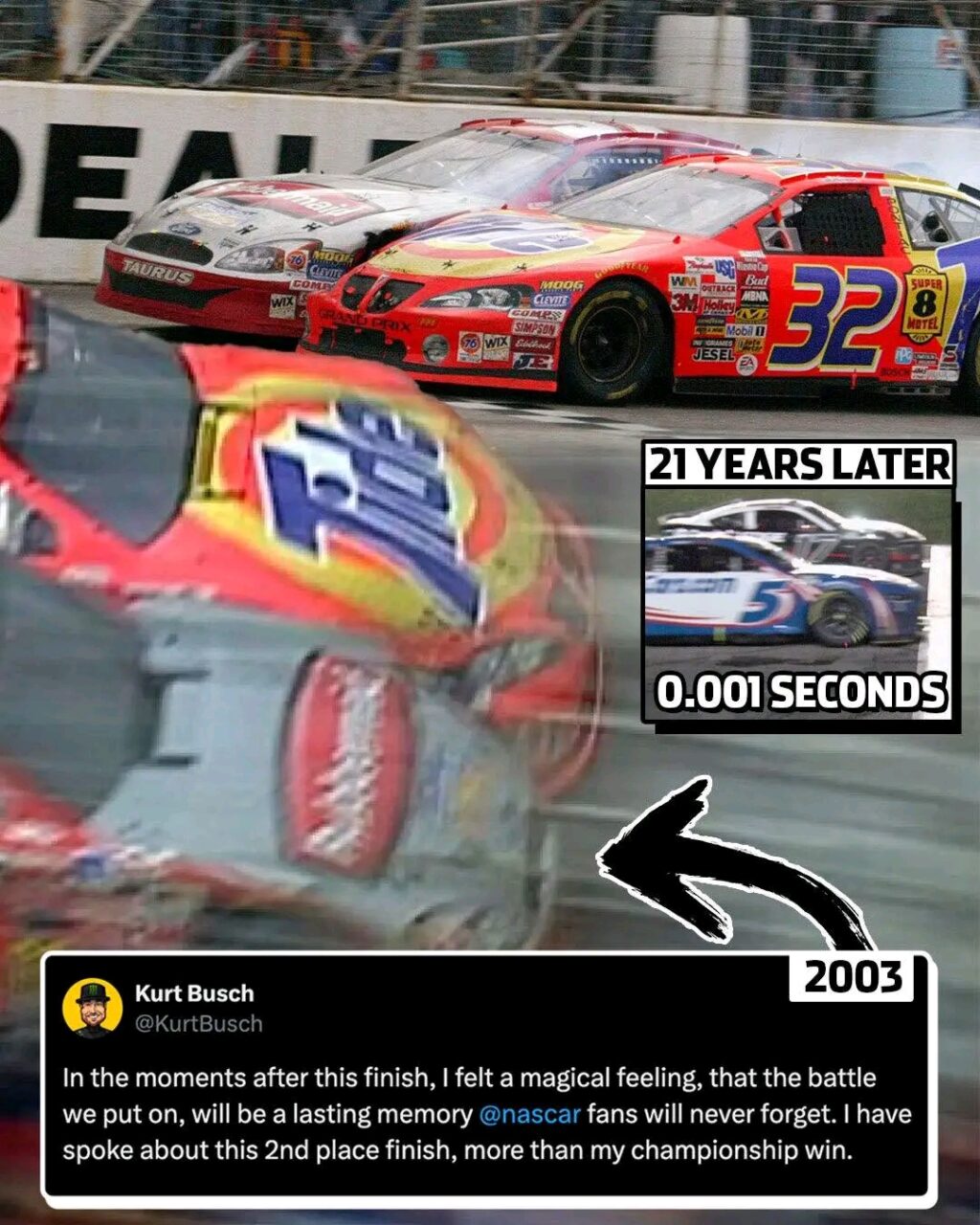
Kurt Busch Reflects on the Closest Finish in NASCAR Cup Series History — A Moment of Pride Amid Defeat
By [Author Name] | May 9, 2025
In a sport built on speed, power, and precision, the difference between glory and heartbreak often comes down to mere inches — or even thousandths of a second. Few drivers know that truth more intimately than former NASCAR Cup Series champion Kurt Busch, who found himself on the wrong side of the closest finish in NASCAR history — a moment of both bitter loss and enduring pride.
Until 2024, the 2003 Cup Series champion held the unenviable distinction of having lost the tightest finish ever recorded in NASCAR’s top series. The moment occurred during the 2003 Carolina Dodge Dealers 400 at Darlington Raceway — a race now cemented in motorsports lore. Busch lost that race to Ricky Craven by a margin of just 0.002 seconds — a blink, a breath, a fraction of a heartbeat. For nearly two decades, that finish remained the gold standard of photo finishes, replayed endlessly in highlight reels and used to define the drama that only NASCAR could deliver.
But in 2024, at Kansas Speedway, history was rewritten when Kyle Larson edged Chris Buescher at the line in a race that officially registered as a 0.001-second margin — shaving off one-thousandth of a second from Busch’s legendary loss.
Even as his place in the record books was dethroned, Kurt Busch’s perspective remains one of humility and reverence. For him, that 2003 Darlington finish wasn’t just a race lost — it was a moment that helped define the raw, thrilling, and deeply emotional essence of NASCAR.
“Even in defeat, I was proud to be part of something so iconic,” Busch said in a recent interview. “It was a pure racing moment — two guys giving everything they had, pushing the limits. That’s what this sport is all about.”
The 2003 Darlington Duel: Inches to Immortality
The race in question was already expected to be competitive. Darlington, affectionately known as “The Lady in Black,” is a notoriously challenging 1.366-mile oval in South Carolina that demands precision, patience, and courage. It was the perfect stage for a dramatic showdown.
On March 16, 2003, fans witnessed one of the most exhilarating finishes in NASCAR history when Ricky Craven and Kurt Busch engaged in a white-knuckled battle over the final laps. With both cars battered and sliding sideways through Turn 4, they banged doors coming to the checkered flag. In the end, it was Craven who inched ahead — by 0.002 seconds.
To this day, many regard that moment as the quintessential NASCAR finish, the moment where grit triumphed over glamour, and where two drivers captured the spirit of stock car racing in one unforgettable sequence.
“When I look back at that day, I don’t think about losing,” Busch reflected. “I think about how epic it was. That race showed everything that’s great about NASCAR — hard racing, respect, and heart.”
Emotions in the Aftermath: Pain, Respect, and Perspective
At the time, the loss stung. Busch had led 10 laps and appeared to have the upper hand in the final turn. The contact with Craven was clean but fierce, and for a brief moment, even the broadcast team was unsure who had won.
“I was in disbelief,” Busch admitted. “You get told you lost by two-thousandths of a second and your brain can’t even process what that means.”
But as time passed, Busch came to see the race for what it was — a rare and beautiful piece of NASCAR history. And rather than fade into bitterness, he embraced his role in one of the sport’s most celebrated moments.
“It wasn’t just a loss. It was a legacy,” he said. “People still talk to me about that race. Fans tell me where they were when they saw it. That means more than any trophy.”
Craven himself has often praised Busch’s sportsmanship and tenacity, saying the race would not have been historic without such a worthy opponent.
“Kurt made that moment,” Craven said in a 2020 interview. “Without him, it wouldn’t have been the same story.”
Fast Forward to 2024: A New Record at Kansas
In May 2024, the motorsports world was once again left speechless as Kyle Larson and Chris Buescher crossed the finish line at Kansas Speedway just 0.001 seconds apart — setting a new record for the closest finish in NASCAR Cup Series history.
The side-by-side dash left fans, commentators, and even NASCAR timing officials stunned. The visual was nearly identical to Busch and Craven’s iconic duel, but this time the margin was even tighter.
For Busch, the moment wasn’t bittersweet. It was celebratory.
“Records are made to be broken,” he tweeted shortly after the Kansas race. “Congrats to Kyle and Chris. That was incredible. I know what that feels like — and I know how proud they both should be.”
He later elaborated in an interview with NASCAR.com, saying,
“I’m actually glad the record was broken. It means the sport is still delivering unforgettable moments. And as someone who’s lived through that thrill, I’m happy to pass the torch.”
Legacy of a Racer: Busch’s Place in NASCAR History
Kurt Busch’s NASCAR career is decorated with accolades: over 30 Cup Series wins, a 2004 championship (the first under the Chase format), and victories with multiple teams across two decades. But for all his success, it is that razor-thin loss at Darlington that continues to define a unique part of his legacy.
And he’s fine with that.
“I’ve had wins that people forget. But nobody forgets that race at Darlington,” he said. “To be remembered for a moment that showed what racing is really about — that’s more than enough for me.”
Busch retired from full-time competition in 2022 due to health concerns stemming from a crash at Pocono. Yet he remains active in the sport as a mentor, consultant, and commentator, offering his insight and support to a new generation of drivers.
The Enduring Power of a Photo Finish
Why do moments like Busch vs. Craven — or Larson vs. Buescher — resonate so deeply with fans?
Because they encapsulate everything NASCAR stands for: fierce competition, high stakes, mutual respect, and the sheer unpredictability of racing.
In a world where outcomes are often determined by strategy and data, a photo finish strips racing down to its core — man, machine, and milliseconds.
“You can’t script that kind of drama,” Busch said. “It’s raw. It’s real. And it’s why people love this sport.”
Looking Ahead: Remembering, Not Rewriting
As NASCAR continues to evolve, embracing new technologies, markets, and fan experiences, it’s moments like the 2003 Darlington finish that keep the sport grounded in its roots.
And while Busch may no longer hold the record for the closest finish, he continues to be an ambassador for what made that moment so timeless.
“Every generation deserves their own iconic finish,” he said. “Mine just came with a bruised bumper and a smile that took a few days to find.”
Whether he’s remembered as a champion, a comeback artist, or the other guy in that unforgettable Darlington finish, Kurt Busch remains a central figure in NASCAR’s modern era — one who understands that victory is sometimes measured not in seconds, but in memories.





